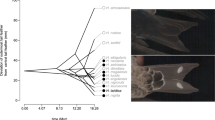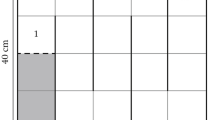Abstract
The ability to learn in the context of predation allows prey to respond to threats by adjusting their behavior based on specific information acquired from their current environment. Habituation is a process that allows animals to adapt to environmental changes. Very little is known about habituation in wild animals in general and there are no studies on habituation in anuran tadpoles in particular. Here, we performed three experiments to investigate the behavioral response of predator naïve Pleurodema thaul tadpoles to repeated stimulation with two predation risk cues (injured conspecific and predator fed cues) which a priori provide different information regarding risk. Experiment 1 showed that P. thaul tadpoles habituate the antipredator response when undergo predation risk chemical cues from injured conspecific and that response is long term. Experiment 2 showed that P. thaul tadpoles did not habituate their antipredator response when exposed to cues derived from an event of nymph odonate preying on P. thaul tadpoles (predator fed cues). Experiment 3 specifically evaluated the risk imposed by each of the risk cues used in Experiment 1 and Experiment 2 and showed that the degree of perceived risk in tadpoles appear to be similar in a single experience with any risk stimuli. We suggest that the behavioral habituation of tadpoles in the context of predation could be modulated by the level of uncertainty associated with risk stimuli.




Similar content being viewed by others
Data availability
All relevant data generated and analyzed during this study are included in this published article. Video recording or unpublished data are available from the corresponding author upon reasonable request.
References
Blumstein DT (2016) Habituation and sensitization: new thoughts about old ideas. Anim Behav 120:255–262. https://doi.org/10.1016/j.anbehav.2016.05.012
Brown GD (1997) Isolated-brain parallels to simple types of learning and memory in Tritonia. Physiol Behav 62:509–518. https://doi.org/10.1016/S0031-9384(97)00008-5
Castellucci VF, Carew TJ, Kandel ER (1978) Cellular analysis of long-term habituation of the gill-withdrawal reflex of Aplysia californica. Science 202:1306–1308. https://doi.org/10.1126/science.214854
Chivers DP, Smith RJF (1998) Chemical alarm signaling in aquatic predator/prey interactions: a review and prospectus. Ecoscience 5:338–352. https://doi.org/10.1080/11956860.1998.11682471
Chivers DP, Mitchell MD, Lucon-Xiccato T, Brown GE, Maud CO, Ferrari MCO (2016) Background risk influences learning but not generalization of predators. Anim Behav 121:185–189. https://doi.org/10.1016/j.anbehav.2016.08.008
Crane AL, Demuth BS, Ferrari MCO (2017) Experience with predators shapes learning rules in larval amphibians. Behav Ecol 28:312–318. https://doi.org/10.1093/beheco/arw161
Domjan M (2003) Principios de aprendizaje y conducta. Thomson, Madrid
Dukas R (2004) Evolutionary biology of animal cognition. Annu Rev Ecol Evol Syst 35:347–374. https://doi.org/10.1146/annurev.ecolsys.35.112202.130152
Eisenstein EM, Eisenstein DL, Sarma JS, Knapp H, Smith JC (2012) Some new speculative ideas about the “behavioral homeostasis theory” as to how the simple learned behaviors of habituation and sensitization improve organism survival throughout phylogeny. Commun Integr Biol 5:233–239. https://doi.org/10.4161/cib.19480
Ellenberg U, Mattern T, Seddon PJ (2009) Habituation potential of yellow eyed penguins depends on sex, character and previous experience with humans. Anim Behav 77:289–296. https://doi.org/10.1016/j.anbehav.2008.09.021
Ferrari MCO, Chivers DP (2011) Learning about non-predators and safe places: the forgotten elements of risk assessment. Anim Cogn 14:309–316. https://doi.org/10.1007/s10071-010-0363-4
Ferrari MCO, Brown GE, Messier F, Chivers DP (2009) Threat sensitive generalization of predator recognition by amphibians. Behav Ecol Sociobiol 63:1369–1375. https://doi.org/10.1007/s00265-009-0779-5
Ferrari MCO, Brown GE, Bortolotti GR, Chivers DP (2010a) Linking predator risk and uncertainty to adaptive forgetting: a theoretical framework and empirical test using tadpoles. Proc R Soc B 277:2205–2210. https://doi.org/10.1098/rspb.2009.2117
Ferrari MCO, Wisenden BD, Chivers DP (2010b) Chemical ecology of predator-prey interactions in aquatic ecosystems: a review and prospectus. Can J Zool 88:698–724. https://doi.org/10.1139/Z10-029
Fraker ME (2008) The dynamics of predation risk assessment: responses of anuran larvae to chemical cues of predators. J Anim Ecol 77:638–645. https://doi.org/10.1111/j.1365-2656.2008.01386.x
Fraker ME (2009) The effect of prior experience on a prey’s current perceived risk. Oecologia 158:765–774. https://doi.org/10.1007/s00442-008-1185-9
Gonzalo A, López P, Martín J (2010) Risk level of chemical cues determines retention of recognition of new predators in Iberian green frog tadpoles. Behav Ecol Sociobiol 64:1117–1123. https://doi.org/10.1007/s00265-010-0927-y
Gosner KL (1960) A simplified table for staging anuran embryos and larvae with notes on identification. Herpetologica 16:183–190. https://doi.org/10.2307/3890061
Guilford T, Dawkins MS (1991) Receiver psychology and the evolution of animal signals. Anim Behav 42:1–14. https://doi.org/10.1016/S0003-3472(05)80600-1
Hemmi JM, Merkle T (2009) High stimulus specificity characterizes anti-predator habituation under natural conditions. Proc R Soc B 276:4381–4388. https://doi.org/10.1098/rspb.2009.1452
Hettyey A, Tóth Z, Thonhauser KE, Frommen JG, Penn DJ, Buskirk JV (2015) The relative importance of prey-borne and predator-borne chemical cues for inducible antipredator responses in tadpoles. Oecologia 179:699–710. https://doi.org/10.1007/s00442-015-3382-7
James EJ, Gu J, Ramirez-Vizcarrondo CM, Hasan M, Truszkowski TL, Tan Y, Oupravanh PM, Khakhalin AS, Aizenman CD (2015) Valproate-induced neurodevelopmental deficits in Xenopus laevis tadpoles. J Neurosci 35:3218–3229. https://doi.org/10.1523/JNEUROSCI.4050-14.2015
Jara FG, Perotti MG (2010) Risk of predation and behavioural response in three anuran species: influence of tadpole size and predator type. Hydrobiologia 644:313–324. https://doi.org/10.1007/s10750-010-0196-9
Jara FG, Úbeda CA, Perotti MG (2013) Predatory insects in lentic freshwater habitats from Northwest Patagonia: richness and phenology. J Nat Hist 47:2749–2768. https://doi.org/10.1080/00222933.2013.791932
Kandel ER, Schwartz JH, Jessell T (1997) Neurociencia y conducta. Prentice Hall, Madrid
Kimber JA, Sims DW, Bellamy PH, Gill AB (2013) Elasmobranch cognitive ability: using electroreceptive foraging behaviour to demonstrate learning, habituation and memory in a benthic shark. Anim Cogn 17:55–65. https://doi.org/10.1007/s10071-013-0637-8
Koops MA (2004) Reliability and the value of information. Anim Behav 67:103–111. https://doi.org/10.1016/j.anbehav.2003.02.008
Kuba MJ, Byrne RA, Meisel DV, Mather JA (2006) Exploration and habituation in intact free moving Octopus vulgaris. Int J Comp Psychol 19:426–438
Mathis A, Ferrari MCO, Windel N, Messier F, Chivers DP (2008) Learning by embryos and the ghost of predation future. Proc R Soc B 275:2603–2607. https://doi.org/10.1098/rspb.2008.0754
McCoy MW, Wheat SK, Warkentin KM, Vonesh JR (2015) Risk assessment based on indirect predation cues: revisiting fine-grained variation. Ecol Evol 5:4523–4528. https://doi.org/10.1002/ece3.1552
Megela AL, Capranica RR (1983) A neural and behavioral study of auditory habituation in the bullfrog, Rana catesbeiana. J Comp Physiol 151:423–434. https://doi.org/10.1007/BF00605458
Mirza RS, Ferrari MCO, Kiesecker JM, Chivers DP (2006) Responses of American toad tadpoles to predation cues: behavioural response thresholds, threat-sensitivity and acquired predation recognition. Behaviour 143:887–889. https://doi.org/10.1163/156853906778017926
Papini MR (2009) Psicología comparada: evolución y desarrollo del comportamiento. El Manual Moderno, Colombia
Polo-Cavia N, Gomez-Mestre I (2014) Learned recognition of introduced predators determines survival of tadpole prey. Funct Ecol 28:432–439. https://doi.org/10.1111/1365-2435.12175
Pueta M, Perotti MG (2016) Anuran tadpoles learn to recognize injury cues from members of the same prey guild. Anim Cogn 19:745–751. https://doi.org/10.1007/s10071-016-0971-8
Pueta M, Cruz FB, Perotti MG (2016) Feeding regime and food availability determine behavioural decisions under predation risk in Pleurodema thaul (Anura: Leiuperidae) tadpoles. Herp J 26:61–64
Pueta M, Andaluz Arcos N, Perotti MG (2017) El estado de alimentación de renacuajos de Pleurodema thaul (Anura: Leptodactylidae) modula la adquisición de un aprendizaje relacionado a riesgo de depredación. Cuad Herpetol 31:83–91
Raderschall CA, Magrath RD, Hemmi JM (2011) Habituation under natural conditions: model predators are distinguished by approach direction. J Exp Biol 214:4209–4216. https://doi.org/10.1242/jeb.061614
Rankin CH, Abrams T, Barry RJ, Bhatnagar S, Clayton DF, Colombo J et al (2009) Habituation revisited: an updated and revised description of the behavioral characteristics of habituation. Neurobiol Learn Mem 92:135–138. https://doi.org/10.1016/j.nlm.2008.09.012
Reichert MS (2010) Aggressive thresholds in Dendropsophus ebraccatus: habituation and sensitization to different call types. Behav Ecol Sociobiol 64:529–539. https://doi.org/10.1007/s00265-009-0868-5
Rodríguez-Prieto I, Martín J, Fernández-Juricic E (2010) Habituation to low-risk predators improves body condition in lizards. Behav Ecol Sociobiol 64:1937–1945. https://doi.org/10.1007/s00265-010-1004-2
Rowe C (2013) Receiver psychology: a receiver’s perspective. Anim Behav 85:517–523. https://doi.org/10.1016/j.anbehav.2013.01.004
Schoeppner NM, Relyea RA (2005) Damage, digestion, and defence: the roles of alarm cues and kairomones for inducing prey defences. Ecol Lett 8:505–512. https://doi.org/10.1111/j.1461-0248.2005.00744.x
Schoeppner NM, Relyea RA (2009) Interpreting the smells of predation: how alarm cues and kairomones induce different prey defenses. Funct Ecol 23:1114–1121. https://doi.org/10.1111/j.1365-2435.2009.01578.x
Shaffery HM, Relyea RA (2015) Dissecting the smell of fear from conspecific and heterospecific prey: investigating the processes that induce anti-predator defenses. Oecologia 180:55–65. https://doi.org/10.1007/s00442-015-3444-x
Shettleworth SJ (2001) Animal cognition and animal behaviour. Anim Behav 61:277–286. https://doi.org/10.1006/anbe.2000.1606
Skelly DK (1994) Activity level and susceptibility of anuran larvae to predation. Anim Behav 47:465–468. https://doi.org/10.1006/anbe.1994.1063
Sztarker J, Tomsic D (2008) Neuronal correlates of the visually elicited escape response of the crab Chasmagnathus upon seasonal variations, stimuli changes and perceptual alterations. J Comp Physiol A 194:587–596. https://doi.org/10.1007/s00359-008-0333-3
Tanabe S, Kasuya E, Miyatake T (2019) Individual and sexual differences in time to habituate to food-stimuli presentation of potential prey in Hyla Japonica. Curr Herpetol 38:14–22. https://doi.org/10.5358/hsj.38.14
Thompson RF, Spencer WA (1966) Habituation: a model phenomenon for the study of neuronal substrates of behavior. Psychol Rev 73:16–43. https://doi.org/10.1037/h0022681
Tomsic D, Massoni V, Maldonado H (1993) Habituation to a danger stimulus in two semiterrestrial crabs: ontogenic, ecological and opioid modulation correlates. J Comp Physiol A 173:621–633. https://doi.org/10.1007/BF00197770
Ydenberg R, Dill L (1986) The economics of fleeing from predators. Adv Study Behav 16:229–249. https://doi.org/10.1016/S0065-3454(08)60192-8
Zylberberg J, DeWeese MR (2011) How should prey animals respond to uncertain threats? Front Comput Neurosci 5:20. https://doi.org/10.3389/fncom.2011.00020
Acknowledgements
We are grateful to P Abate and the two anonymous reviewers who provided helpful comments to improve this work.
Funding
This work was supported by Universidad Nacional del Comahue (UNCo 04/B 237), Argentina.
Author information
Authors and Affiliations
Corresponding author
Ethics declarations
Conflict of interest
The authors declare that they have no conflict of interest.
Ethical standard
Experiments were performed under the Guidelines for Use of Live Amphibians and Reptiles in Field Research (ASIH). Experiments followed the ethical norms imposed by Argentina (APN N° 1231). Animals for this study were collected with the permission of Secretaría de Ambiente y Desarrollo Sustentable, Río Negro (1532/2018) and Secretaria de Medio Ambiente of San Carlos de Bariloche, Río Negro, Argentina (N° 250—DAP-2018).
Consent to participate
All the authors gave their consent to participate in this article.
Consent for publication
All the authors gave their consent to publish this work.
Additional information
Publisher's Note
Springer Nature remains neutral with regard to jurisdictional claims in published maps and institutional affiliations.
Rights and permissions
About this article
Cite this article
Pueta, M., Ardanaz, D. & Tallone, J.C. Habituation in anuran tadpoles and the role of risk uncertainty. Anim Cogn 25, 63–72 (2022). https://doi.org/10.1007/s10071-021-01534-z
Received:
Revised:
Accepted:
Published:
Issue Date:
DOI: https://doi.org/10.1007/s10071-021-01534-z




